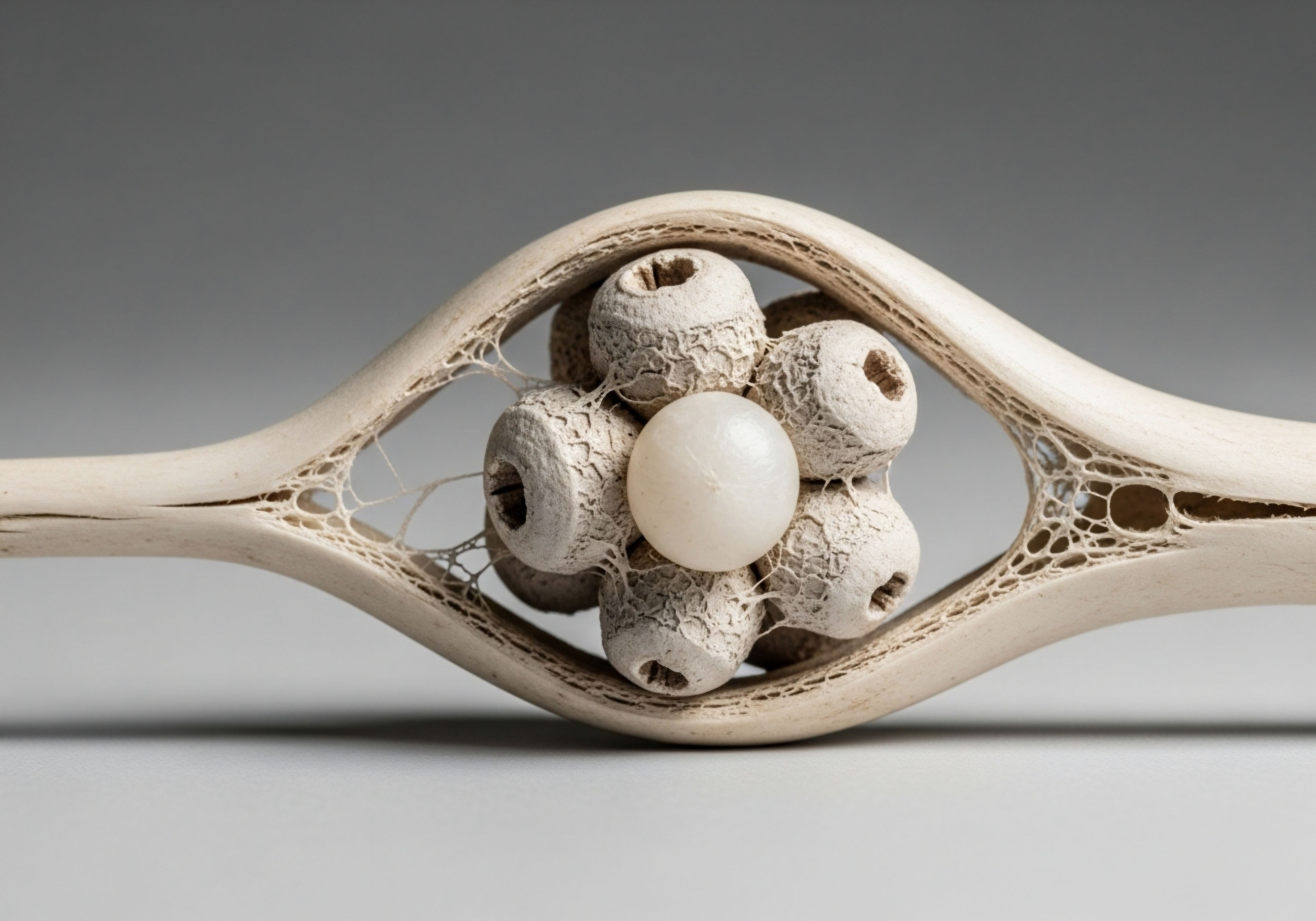

Fundamentals
Perhaps you have noticed a subtle shift in your physical resilience, a lingering ache after a minor bump, or a growing concern about your bone health as the years accumulate. This experience, often dismissed as an inevitable part of growing older, carries a deeper biological story.
It speaks to the intricate, often overlooked, dialogue happening within your body’s internal systems, particularly the endocrine network. Your bones, far from being static structures, are dynamic, living tissues constantly undergoing a process of renewal. This continuous remodeling ensures their strength and integrity, adapting to the demands of daily life. When this delicate balance falters, the consequences can range from minor discomfort to significant fragility, impacting your vitality and independence.
Understanding this internal conversation is the first step toward reclaiming your physical resilience. The body possesses remarkable self-regulating capabilities, orchestrated by a symphony of chemical messengers. Among these, hormones and peptides play central roles, acting as the conductors of cellular activity.
When their signaling becomes disrupted, whether through the natural progression of age or other physiological stressors, the impact can be felt across multiple systems, including the skeletal framework. Our exploration begins by acknowledging your personal experience, then translates the complex biological mechanisms into actionable knowledge, allowing you to comprehend the ‘why’ behind these changes and the potential paths toward restoration.

The Dynamic Nature of Bone
Bone tissue is in a perpetual state of flux, a process known as bone remodeling. This involves a coordinated effort between two primary cell types ∞ osteoblasts, which are responsible for building new bone matrix, and osteoclasts, which break down old bone tissue.
This continuous cycle ensures the repair of micro-damage, the maintenance of mineral homeostasis, and the adaptation of bone structure to mechanical loads. In younger years, bone formation generally outpaces or matches bone resorption, leading to peak bone mass. As individuals age, particularly after the fifth decade, this equilibrium often shifts, with resorption beginning to exceed formation, leading to a gradual reduction in bone mineral density. This imbalance is a primary contributor to conditions such as osteopenia and osteoporosis.
Bone remodeling is a continuous, balanced process of bone formation and resorption, essential for skeletal health.

Hormonal Orchestration of Bone Health
The intricate dance of bone remodeling is precisely regulated by a complex interplay of hormones. These biochemical messengers act as critical signals, influencing the activity and lifespan of both osteoblasts and osteoclasts. Key players include parathyroid hormone, calcitonin, vitamin D, and, significantly for our discussion, sex steroid hormones and growth hormone.
Each contributes a unique regulatory influence, ensuring the skeletal system responds appropriately to physiological needs. When the production or reception of these hormonal signals diminishes, the skeletal system can become compromised, leading to increased fragility.
Consider the role of estrogen, a hormone often associated with female reproductive health, yet profoundly important for bone integrity in both women and men. Estrogen primarily exerts its protective influence by suppressing the activity of osteoclasts, thereby reducing bone resorption. A decline in estrogen levels, such as during menopause, directly accelerates bone loss due to unchecked osteoclast activity.
Similarly, testosterone, while acting directly on bone cells, also contributes to bone health through its conversion into estrogen within bone tissue itself. This dual mechanism underscores the interconnectedness of the endocrine system and its systemic impact.
Another vital regulator is growth hormone (GH), a peptide hormone secreted by the pituitary gland. GH, along with its mediator insulin-like growth factor 1 (IGF-1), stimulates both bone formation and resorption, leading to an overall increase in bone turnover and net bone accumulation during growth and maintenance.
A reduction in GH and IGF-1 levels, common with aging, contributes to a slower rate of bone remodeling and a gradual decline in bone mineral density. Understanding these foundational hormonal influences sets the stage for appreciating how targeted peptide therapies might recalibrate these systems.


Intermediate
Having explored the foundational mechanisms of bone remodeling and the crucial role of endogenous hormones, we now turn our attention to specific clinical protocols designed to support skeletal integrity, particularly focusing on peptide therapies. These interventions aim to restore the body’s innate capacity for renewal by providing precise biochemical signals. The approach involves understanding the ‘how’ and ‘why’ of these therapeutic agents, recognizing their specific actions within the complex biological network.

Targeted Hormonal Optimization Protocols
Hormonal balance is paramount for bone health. When natural hormone production wanes with age, targeted replacement strategies can provide significant support.

Testosterone Replacement Therapy Men
For men experiencing symptoms of low testosterone, often termed andropause, testosterone replacement therapy (TRT) can be a valuable intervention. Beyond its well-known effects on muscle mass, energy, and libido, testosterone plays a direct and indirect role in maintaining bone mineral density. Protocols often involve weekly intramuscular injections of Testosterone Cypionate (200mg/ml).
To maintain natural testicular function and fertility, Gonadorelin (2x/week subcutaneous injections) may be included. This peptide stimulates the release of luteinizing hormone (LH) and follicle-stimulating hormone (FSH) from the pituitary gland, which in turn signal the testes to produce testosterone and sperm.
Managing estrogen levels is also a consideration in male hormonal optimization. Testosterone can convert to estrogen via the aromatase enzyme, and while some estrogen is beneficial for bone health, excessive levels can lead to undesirable effects. Therefore, an aromatase inhibitor such as Anastrozole (2x/week oral tablet) may be prescribed to modulate this conversion. In certain scenarios, medications like Enclomiphene might be incorporated to specifically support LH and FSH levels, further promoting endogenous testosterone production.

Testosterone Replacement Therapy Women
Women, whether pre-menopausal, peri-menopausal, or post-menopausal, can also experience symptoms related to suboptimal testosterone levels, including low libido, mood changes, and bone density concerns. Protocols for women typically involve lower doses of Testosterone Cypionate, often 10 ∞ 20 units (0.1 ∞ 0.2ml) weekly via subcutaneous injection. The precise dosage is carefully calibrated to individual needs and symptom presentation.
Progesterone is another critical hormone for female hormonal balance, particularly in peri- and post-menopausal women. Its prescription is tailored to the individual’s menopausal status and specific symptoms. Some women may also opt for Pellet Therapy, which involves the subcutaneous insertion of long-acting testosterone pellets, offering a sustained release of the hormone.
When appropriate, Anastrozole may also be considered in women to manage estrogen levels, although this is less common than in men due to the differing physiological roles of estrogen in female bone health.
Hormonal optimization, including testosterone and progesterone, supports bone health by restoring physiological balance.

Growth Hormone Peptide Therapy
Beyond traditional hormone replacement, specific peptides can directly influence growth hormone pathways, offering a targeted approach to support overall vitality, including bone health. These peptides are not growth hormone itself, but rather secretagogues, meaning they stimulate the body’s own pituitary gland to produce and release more growth hormone. This approach aims to restore more youthful levels of GH and IGF-1, which are known to decline with age and contribute to reduced bone remodeling.
Key peptides in this category include ∞
- Sermorelin ∞ This peptide mimics the natural growth hormone-releasing hormone (GHRH) produced by the hypothalamus. It stimulates the pituitary gland to release GH in a pulsatile, physiological manner. Its action is relatively short-lived, requiring more frequent administration.
- Ipamorelin / CJC-1295 ∞ This combination is frequently employed for a more sustained elevation of GH. Ipamorelin is a selective growth hormone secretagogue that stimulates GH release without significantly affecting other hormones like cortisol or prolactin. CJC-1295 is a GHRH analog with a long half-life, which allows it to remain active in the body for several days, providing a prolonged increase in GH levels. When combined, they offer a potent synergy for GH release, supporting muscle gain, fat loss, and potentially bone density.
- Tesamorelin ∞ This GHRH analog is primarily recognized for its role in reducing visceral adipose tissue. While its direct impact on bone density is less emphasized in general use, improvements in metabolic health can indirectly support skeletal well-being.
- Hexarelin ∞ Similar to Ipamorelin, Hexarelin is a growth hormone secretagogue. It is a potent stimulator of GH release, but it can also influence cortisol and prolactin levels, making its application more specific.
- MK-677 (Ibutamoren) ∞ This is an orally active, non-peptide ghrelin mimetic that stimulates GH and IGF-1 secretion (from MK-677 search). While it increases markers of bone formation and reduces resorption, its direct impact on bone mineral density has shown mixed results in studies, with some indicating modest increases or even slight decreases in specific sites, and long-term fracture risk reduction remains to be conclusively demonstrated (from MK-677 search).
The mechanism by which these GH-stimulating peptides may support bone health involves enhancing the overall rate of bone remodeling. By increasing the levels of GH and IGF-1, they can stimulate osteoblast activity, leading to increased bone formation. This renewed anabolic drive can help counteract the age-related decline in bone density.

Other Targeted Peptides
Beyond growth hormone secretagogues, other peptides offer specialized support that can indirectly or directly contribute to overall well-being, which in turn supports skeletal health.
- PT-141 (Bremelanotide) ∞ This peptide is primarily used for sexual health, addressing issues of low libido in both men and women. While not directly targeting bone, improved quality of life and hormonal balance can have systemic benefits.
- Pentadeca Arginate (PDA) ∞ This peptide is recognized for its roles in tissue repair, healing, and modulating inflammation. Chronic inflammation can negatively impact bone health by promoting osteoclast activity and inhibiting osteoblast function. By supporting tissue repair and reducing inflammation, PDA could indirectly contribute to a more favorable environment for bone maintenance.
The selection of specific peptides and their integration into a personalized wellness protocol requires careful consideration of individual health status, goals, and existing hormonal profiles. The aim is always to recalibrate the body’s systems, allowing for optimal function and resilience.
| Peptide Class | Specific Peptides | Primary Mechanism Relevant to Bone | Observed Effects on Bone/Related Systems |
|---|---|---|---|
| Growth Hormone Secretagogues | Sermorelin, Ipamorelin, CJC-1295, Hexarelin | Stimulate endogenous GH release from pituitary, increasing IGF-1. | Increased bone turnover, potential for increased bone mineral content, improved muscle mass supporting skeletal load (from CJC/Sermorelin search). |
| Ghrelin Mimetic | MK-677 (Ibutamoren) | Oral agonist of ghrelin receptor, stimulating GH and IGF-1. | Increases markers of bone formation and resorption; mixed results on direct BMD increases; long-term fracture risk not established (from MK-677 search). |
| Collagen Peptides | Specific Bioactive Collagen Peptides | Provide building blocks for bone matrix, stimulate osteoblasts. | Increases bone mineral density in lumbar spine and femoral neck in postmenopausal women; favorable shift in bone markers (from Peptide Therapy search). |
| Sex Hormone Modulators | Gonadorelin, Anastrozole, Enclomiphene | Influence endogenous sex hormone production and metabolism. | Support optimal testosterone and estrogen levels, which are critical for bone density and remodeling (from Testosterone/Estrogen search). |


Academic
To truly comprehend the potential of peptide therapies in addressing severe bone loss, a deeper scientific exploration is essential. This requires delving into the intricate endocrinology and systems biology that govern skeletal health, moving beyond superficial descriptions to analyze the molecular and cellular interplay. We aim to connect the dots between complex biological axes, metabolic pathways, and cellular signaling, always linking these insights back to the ultimate goal of enhancing human well-being.

The Hypothalamic-Pituitary-Gonadal Axis and Bone Integrity
The Hypothalamic-Pituitary-Gonadal (HPG) axis represents a central regulatory pathway for reproductive hormones, yet its influence extends profoundly to skeletal health. The hypothalamus releases gonadotropin-releasing hormone (GnRH), which signals the pituitary gland to secrete luteinizing hormone (LH) and follicle-stimulating hormone (FSH). These gonadotropins, in turn, stimulate the gonads (testes in men, ovaries in women) to produce sex steroid hormones, primarily testosterone and estrogen.
The decline in sex steroid levels with aging, particularly the sharp drop in estrogen during menopause and the more gradual reduction in testosterone in men, directly impacts bone remodeling. Estrogen deficiency accelerates bone resorption by increasing the lifespan and activity of osteoclasts and by promoting the production of pro-inflammatory cytokines such as interleukin-6 (IL-6) and tumor necrosis factor-alpha (TNF-α), which further stimulate osteoclastogenesis.
Estrogen also plays a role in preventing osteocyte apoptosis, cells that are crucial for sensing mechanical stress and coordinating bone remodeling.
Testosterone’s influence on bone is multifaceted. It acts directly on androgen receptors (ARs) present on osteoblasts and osteocytes, promoting bone formation and inhibiting osteoblast apoptosis. Additionally, testosterone undergoes aromatization to estrogen within bone tissue, allowing it to exert estrogenic effects on bone cells, particularly in suppressing osteoclast activity.
This dual mechanism highlights why maintaining optimal levels of both testosterone and estrogen, even in men, is critical for preserving skeletal integrity. Gonadorelin, by stimulating the HPG axis, aims to restore this endogenous hormonal production, offering a physiological approach to supporting bone health.

Growth Hormone and IGF-1 Signaling in Bone Metabolism
The somatotropic axis, comprising growth hormone (GH) and insulin-like growth factor 1 (IGF-1), is another central regulator of bone metabolism. GH, secreted by the anterior pituitary, stimulates the liver and other tissues, including bone, to produce IGF-1. Both GH and IGF-1 exert direct and indirect effects on bone cells.
GH directly stimulates osteoblast proliferation and differentiation, enhancing bone formation. It also influences osteoclast differentiation and activity, leading to an overall increase in bone turnover. IGF-1, often considered the primary mediator of GH’s anabolic effects on bone, promotes osteoblast proliferation, differentiation, and maturation, contributing to bone matrix synthesis and mineralization.
The binding of IGF-1 to its receptor on osteoblasts activates crucial intracellular signaling pathways, such as the phosphoinositide 3-kinase/protein kinase B (PI3K/Akt) and mitogen-activated protein kinase (MAPK) pathways, which are vital for bone formation.
The decline in GH and IGF-1 levels with age contributes to a reduction in bone remodeling rates and a net loss of bone mineral density. Growth hormone secretagogues like Sermorelin, Ipamorelin, and CJC-1295 work by enhancing the pulsatile release of endogenous GH, thereby elevating IGF-1 levels. This aims to restore a more youthful anabolic drive within the skeletal system, potentially reversing the age-related shift towards increased bone resorption.
Growth hormone secretagogues aim to restore youthful anabolic drive in bone by elevating GH and IGF-1 levels.

Peptide Mechanisms in Bone Remodeling
The direct and indirect actions of various peptides on bone cells and their signaling pathways represent a frontier in addressing bone loss.

Collagen Peptides and Bone Matrix Synthesis
Specific bioactive collagen peptides (SCP) have shown promise in clinical trials for improving bone mineral density in postmenopausal women. These peptides are not merely structural components; they act as signaling molecules. When ingested, they are absorbed and can reach bone tissue, where they are thought to stimulate osteoblasts directly.
Preclinical studies suggest that collagen peptides can increase the organic component of bones, improve bone metabolism, and enhance bone microarchitecture. They may also trigger the formation of osteoblasts from bone marrow cells and promote osteoblast activity, leading to increased bone mineralization and synthesis of organic bone components. This direct stimulation of bone-building cells offers a unique pathway for supporting skeletal health.

The Role of Ghrelin Mimetics and Bone Markers
MK-677, as a ghrelin mimetic, stimulates the ghrelin receptor, leading to increased GH and IGF-1 secretion (from MK-677 search). While its primary effect is on body composition, studies have investigated its impact on bone. Research indicates that MK-677 can increase markers of both bone formation (like osteocalcin and bone-specific alkaline phosphatase) and bone resorption (like N-telopeptide cross-links) (from MK-677 search).
This suggests an overall increase in bone turnover. However, the translation of these changes in markers to significant, consistent increases in bone mineral density across all skeletal sites, or a reduction in fracture risk, has not been definitively established in large, long-term clinical trials (from MK-677 search).
Some studies have even noted a small decrease in femoral neck BMD with MK-677 compared to placebo over 12 months (from MK-677 search). This highlights the complexity of bone remodeling, where increased turnover does not always equate to net bone gain, especially in older adults where the balance is already shifted towards resorption.
The interplay between bone formation and resorption markers is critical. While MK-677 increases both, the desired outcome for bone loss reversal is a net positive balance favoring formation. The attenuation of bone formation suppression when MK-677 was combined with alendronate, an anti-resorptive drug, suggests a potential for synergistic effects, but more research is needed to clarify the optimal strategies for combining anabolic and anti-resorptive agents (from MK-677 search).

Can Peptide Therapies Reverse Severe Bone Loss in Older Adults?
The question of whether peptide therapies can reverse severe bone loss in older adults is complex, requiring a nuanced understanding of their mechanisms and clinical evidence. While traditional anti-resorptive drugs like bisphosphonates primarily slow bone breakdown, anabolic agents, including certain peptides, offer the promise of actively building new bone.
Anabolic agents such as teriparatide (a parathyroid hormone analog) and abaloparatide are established treatments for osteoporosis, known to stimulate bone formation and significantly increase bone mineral density (from Peptide Therapy search). While these are not typically classified as “peptide therapies” in the broader sense of the growth hormone secretagogues discussed, they are indeed peptide-based drugs that demonstrate the power of targeted peptide signaling for bone anabolism.
Romosozumab, an anti-sclerostin monoclonal antibody, also stimulates bone formation and inhibits resorption, showing significant increases in BMD (from Peptide Therapy search).
The growth hormone secretagogue peptides (Sermorelin, Ipamorelin, CJC-1295) aim to achieve a similar anabolic effect by physiologically stimulating the body’s own GH and IGF-1 production. Animal studies with Ipamorelin have shown promising results in increasing bone formation (from CJC/Sermorelin search).
However, the direct translation of these findings to significant reversal of severe bone loss in human older adults, specifically demonstrating fracture risk reduction, requires more extensive, long-term human clinical trials. The existing evidence for GH secretagogues primarily points to their ability to increase bone turnover and, in some cases, bone mineral content, rather than a consistent, substantial increase in volumetric bone mineral density (from CJC/Sermorelin search).
Collagen peptides, as discussed, represent a distinct category with evidence for improving BMD in postmenopausal women (from Peptide Therapy search). This suggests a direct contribution to the organic matrix of bone, which is a fundamental component of bone strength.
The potential for peptide therapies to reverse severe bone loss lies in their capacity to re-engage the body’s intrinsic anabolic pathways. While the evidence for some specific peptides, like collagen peptides, is becoming more robust, and the physiological rationale for GH secretagogues is strong, the definitive long-term clinical outcomes, particularly regarding fracture prevention in severe osteoporosis, are still areas of active research.
A personalized approach, considering the individual’s hormonal profile, overall health, and the specific mechanisms of action of each peptide, is paramount.
| Hormone/Peptide | Primary Effect on Osteoblasts (Bone Formation) | Primary Effect on Osteoclasts (Bone Resorption) | Net Effect on Bone Remodeling |
|---|---|---|---|
| Estrogen | Supports activity, prevents apoptosis | Inhibits formation and activity | Reduces resorption, favors formation |
| Testosterone | Stimulates proliferation and differentiation | Indirectly inhibits (via aromatization to estrogen) | Promotes formation, reduces resorption |
| Growth Hormone (GH) / IGF-1 | Stimulates proliferation and activity | Stimulates differentiation and activity (overall turnover) | Increases overall turnover, net accumulation |
| GH Secretagogues (e.g. Ipamorelin) | Indirectly stimulates via GH/IGF-1 increase (from CJC/Sermorelin search) | Indirectly influences via GH/IGF-1 increase (from CJC/Sermorelin search) | Increases bone turnover, potential for increased formation (from CJC/Sermorelin search) |
| Collagen Peptides | Stimulates formation, increases organic matrix (from Peptide Therapy search) | Reduces degradation (from Peptide Therapy search) | Favors formation, improves matrix quality |
| MK-677 | Increases markers of formation (from MK-677 search) | Increases markers of resorption (from MK-677 search) | Increases overall turnover; net BMD effect varies (from MK-677 search) |

References
- König, Daniel, et al. “Specific Collagen Peptides Improve Bone Mineral Density and Bone Markers in Postmenopausal Women ∞ A Randomized Controlled Study.” Nutrients, vol. 10, no. 1, 2018, p. 97.
- Nass, Ralf, et al. “Effects of an Oral Ghrelin Mimetic on Body Composition and Clinical Outcomes in Healthy Older Adults ∞ A Randomized Trial.” Annals of Internal Medicine, vol. 149, no. 9, 2008, pp. 603-11.
- Murphy, M. G. et al. “Effect of Alendronate and MK-677 (a Growth Hormone Secretagogue), Individually and in Combination, on Markers of Bone Turnover and Bone Mineral Density in Postmenopausal Osteoporotic Women.” The Journal of Clinical Endocrinology & Metabolism, vol. 86, no. 3, 2001, pp. 1116-25.
- Riggs, B. Lawrence, et al. “The Mechanisms of Estrogen Regulation of Bone Resorption.” Journal of Clinical Investigation, vol. 106, no. 10, 2000, pp. 1203-04.
- Vanderschueren, Dirk, et al. “Testosterone and Male Bone Health ∞ A Puzzle of Interactions.” Journal of Bone and Mineral Research, vol. 35, no. 1, 2020, pp. 1-15.
- Khosla, Sundeep, and L. Joseph Melton. “Osteoporosis ∞ Novel Treatments.” Annual Review of Medicine, vol. 59, 2008, pp. 343-56.
- Svensson, Johan, et al. “The GH Secretagogues Ipamorelin and GH-Releasing Peptide-6 Increase Bone Mineral Content in Adult Female Rats.” Journal of Endocrinology, vol. 165, no. 3, 2000, pp. 569-77.
- Callewaert, Françoise, et al. “The Mutual Dependence Between Bone and Gonads in Male and Female Skeletons.” Journal of Endocrinology, vol. 207, no. 1, 2010, pp. 1-10.
- Mohamad, Nurulamin, et al. “A Concise Review of Testosterone and Bone Health.” Clinical Interventions in Aging, vol. 11, 2016, pp. 1317-24.
- Taxel, Pamela, et al. “Changes in Urinary Excretion of Helical Peptide during Therapy for Osteoporosis in Older Adults.” Clinical Chemistry, vol. 48, no. 1, 2002, pp. 161-65.

Reflection
As we conclude this exploration, consider the profound capabilities residing within your own biological systems. The journey toward understanding hormonal health and metabolic function is not merely about addressing symptoms; it is about reclaiming a deeper connection with your body’s inherent intelligence. The insights shared here are not a definitive endpoint, but rather a starting point for your personal path toward renewed vitality.
The information presented offers a framework for comprehending the intricate biological conversations that shape your well-being. True personalized wellness protocols emerge from a collaborative process, integrating scientific knowledge with your unique physiological landscape and lived experience. This knowledge empowers you to engage more fully in discussions about your health, asking informed questions and seeking guidance that resonates with your individual needs.
Your body possesses an extraordinary capacity for adaptation and restoration. By aligning with its natural rhythms and providing targeted support, you can work toward a future where vitality and function are not compromised, but rather optimized.



